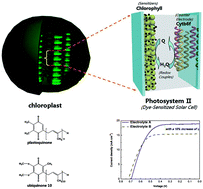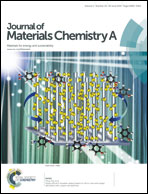Efficient dye-sensitized solar cells employing highly environmentally-friendly ubiquinone 10 based I2-free electrolyte inspired by photosynthesis†
Abstract
A highly environmentally-friendly ubiquinone 10 (UQ10) based I2-free electrolyte, which is inspired by photosynthesis, is employed in dye-sensitized solar cells (DSSCs) under 100 mW cm−2 (AM 1.5G) illumination. Profiting from this UQ10 based electrolyte a 10% increased power conversion efficiency of 8.18% is achieved compared with the traditional one containing I2 (7.44%). The superior performance of this UQ10 based electrolyte is mainly derived from the lower visible light wastage and high catalytic activity to the counter electrode as revealed by photoelectrochemical characterization. Moreover, being widely adopted in cardiovascular medicine and cosmetics, UQ10 is a very safe and low-cost choice for DSSCs. With the advantages of high power conversion efficiency, bio-safety, universal dye compatibility and diversity of molecular design, UQ10 is very promising to be widely applied in DSSCs, and perovskite based solar cells.


 Please wait while we load your content...
Please wait while we load your content...